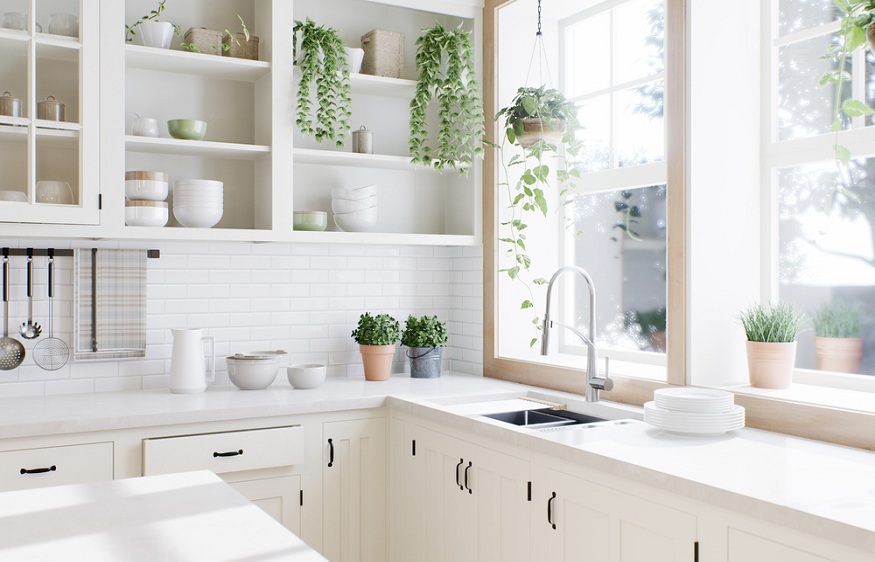According to the experts at Bedrock Quartz, a new countertop installation can completely transform the look of your kitchen or bath. While they recommend professional installation for natural stone and larger projects, DIY-savvy homeowners can tackle simple countertop replacements like prefab laminate themselves.

Take Precise Measurements
Measure existing countertops, including overhangs and cutouts, carefully to size replacement tops accurately. Account for uneven walls or problem areas and make detailed drawings that note all measurements and specifications.
Gather Required Tools and Materials
Check the manufacturer’s installation guide for recommended tools, supplies and hardware. Have on hand adhesives, caulk, clamps, saw, drill, and safety gear needed. Stage all materials conveniently before starting work.
Disconnect Sinks, Fixtures and Backsplashes
Turn off water supply lines and disconnect plumbing. Remove sink basins and faucets. Take down backsplash tile or panels carefully to avoid damaging walls.
Cut Countertop Surfaces with Circular Saw
Use a corded circular saw with a carbide blade to cut countertops into manageable sections for carrying. Make relief cuts out from edges first, then cut lengthwise. Go slowly to keep the saw steady and avoid slipping. Wear proper eye and ear protection when sawing.
Pry Away Sections with Pry Bar
After making cuts, pry countertop pieces loose using a flat pry bar. Apply steady force along seams to pop tops free from cabinet bases and walls. Remove any stubborn nails or screws holding sections in place.
Have Countertops Professionally Fabricated
Even when self-installing, have countertops made to fit your cabinets precisely. Provide detailed drawings and measurements to fabricators. For sinks and stoves, supply the exact appliances being used so cutouts align perfectly.
Make Sure Cabinets are Level and Secured
Confirm cabinets are level front to back and side to side before setting countertops. Secure cabinets to walls with brackets or L-brackets so they don’t shift under counterweight.
Dry Fit Countertops Before Permanently Installing
Place pre-cut countertops temporarily to ensure proper fit around walls and cabinet perimeters. Make any necessary adjustments before permanent installation.
Apply Adhesive to Cabinets and Countertops
Run a continuous serpentine bead of manufacturer-approved adhesive along the top edges of cabinet bases where countertops will contact. Also apply adhesive to the underside of countertops along edges and over studs.
Set Countertops in Place and Press Down Firmly
Have helpers carefully lower countertops onto cabinets. Position correctly, then press down hard over entire surface to adhere strongly. Use a J-roller to seal the bond and fill any slight gaps with caulk.
Clamp Sections Together Tightly
Where counters meet at seams, draw joint together tightly with C-clamps. Follow prescribed methods to fuse seam edges like gluing, taping, clipping, and screwing together using provided seam kits.
Reinstall Sinks, Faucets and Accessories
With countertops firmly bonded, carefully place sink basins and vanities back into cutouts following manufacturer instructions. Reconnect drainpipes, supply lines, disposals, and fixtures, and seal with clear silicone caulk.
Reconnect and Check Plumbing Connections
Ensure drainpipes align properly and supply lines flow well with no leaks at valves or couplings. Open and close faucets to release any air in the lines and fix any drip or flow issues immediately.
Finish Edges and Seams for a Seamless Look
If edges are unfinished, apply trim strips or acrylic edging for a neat uniform look. Use silicone sealant to fill any cracks or gaps, especially around sinks and faucets.
Install New Backsplash Tiles or Panels
Apply backsplash tile, glass or other backsplash materials using appropriate adhesive for a finished custom look. Seal bottom edges with caulk. Take care removing old backsplashes to avoid damaging the wallboard.
Conclusion
Installing new countertops yourself can save thousands over professional replacement. With proper planning, precision cuts, and strategic installation, even DIYers can achieve beautiful results.










Leave a Reply
You must be logged in to post a comment.